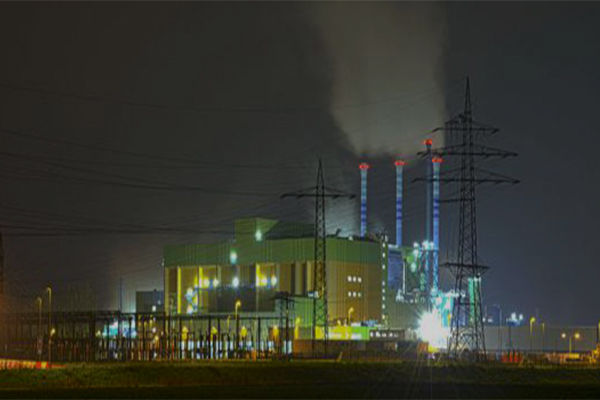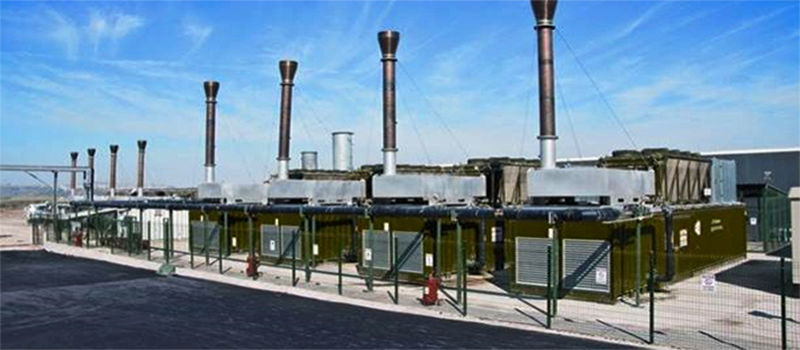Waste to Energy
Powering Energy from Municipal Solid Waste as a solution towards waste problem.
Our Vision:
We Envision an Environmentally Friendly Tomorrow that is Economically inviting, Socially Healthful and where Waste To Clean-Renewable Energy Technology has Solved the Romanian Waste management Problem.
Consumption and the diversity/increase of needs has induced the necessity to utilize our resources in the best way possible while finding a viable solution for waste management.
PROTORELIEF SRL is a rapidly growing consultancy company that is based on the expertise and experience of engineers, who have implemented large-scale projects in the energy sector.
Our proven accomplishments in our previous projects allow us to seamlessly implement new projects successfully. Starting as a consultancy company, PROTORELIEF SRL will enlarge our scope in becoming a subcontractor for many activities, which are related to future projects. These activities will be implemented by skilled people, hired by us, which includes our engineers and professionals who are specialists in their respective domains. Our main target market is the Romanian waste management sector that is coordinated by the PNGD. However, we believe that this will be extended based on our diverse experience.
PROTORELIEF SRL reduces municipal waste and turns it into clean energy. Using municipal waste is directly in line with the vision of the Romanian government programs and their National Energy Policy, which encourages the development and utilization of New and Renewable (EBT) bio-energy.
As stipulated in the Government Regulation called Romanian Plan for Management of the Waste 2018 – 2025 (PNGD), converting municipal waste into renewable energy will play a vital role in improving the supply of energy, which will support the energy requirements of the community. Furthermore, the reduction of greenhouse gas emissions and waste will lower pollution, which will eventually enhance the national economy and improve public health.
Important note:
In this site, we are presenting technologies, pictures, schemes, diagrams of the most known waste management processes and in particular, their use as renewable energy sources. These processes are the result of global development along many decades and of the implementation in large-scale applications. These processes are not the patents or inventions of our company. These processes belong to the most famous international companies. Over time, these have been taken over and extended by other companies. We are presenting this information only to provide our clients different basic data useful for chosing the best solutions for their projects in renewable energy and waste preparation in a circular economy. Our intention is to asimilate them and implement in Romania alone or in a better way together with international partners.

We are active in Romania in 4 key areas that are in accordance with the PNGD (Romanian Plan for Management of the Waste 2018 – 2025):
1. Thermal incineration
A high temperature waste treatment process for MSW and biomass, involves the combustion of organic substances found in waste materials and uses boilers and turbine equipment to generate heat and power.
Advantages:
1. Reduces Pollution;
2. Volume and quantity of waste is reduced;
3. Generates power and heat without significant toxic particle emissions.
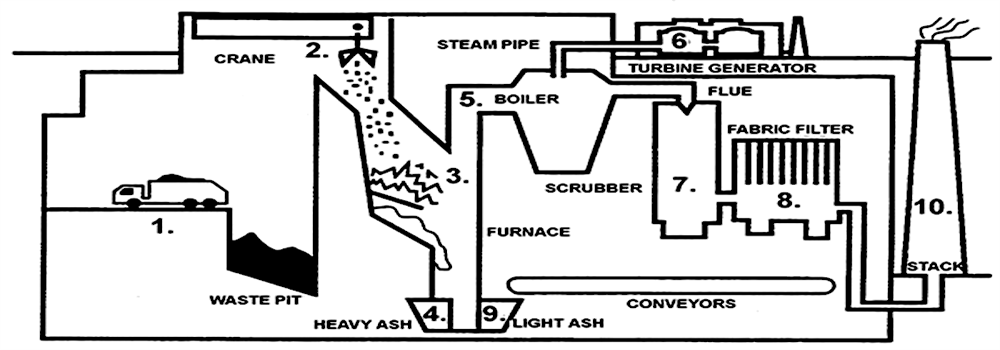
Diagram for functioning Waste for Energy Incinerator
1. Waste Pit;
2. Crane;
3. Furnace;
4. Heavy ash;
5. Boiler;
6. Turbine generator;
7. Scrubber;
8. Fabric filter;
9. Light ash;
10. Stack.
2. Anaerobic Digestion (AD)
Biogas and Digestate Preparations and Usage:
- Biogas as fuel in cogeneration plants for heat and power (CHP);
- Digestate usage as fertilizer in agriculture.
Anaerobic digestion; biogas and digestate preparations and usage; cogeneration plants for heat and power (CHP).
Advantages:
1. Fastest yearly global growth that approximately 10%;
2. Openings to be applicable in Romania;
3. Eco-friendly;
4. Simple and low cost technology.
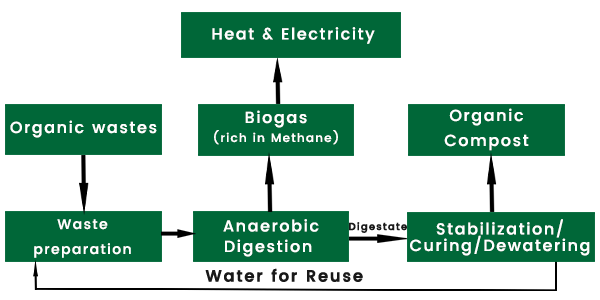
Diagram for functioning AD, AE processes
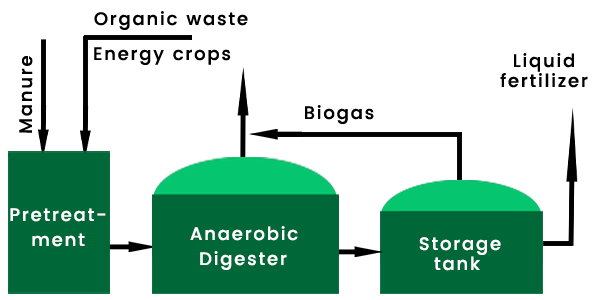
Process flow of a Simple Biogas Plant
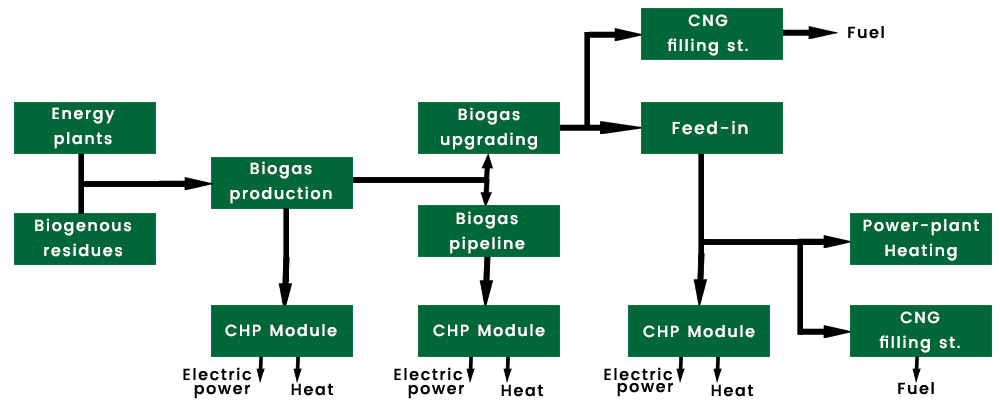
Diagram for producing, preparation and usage of the biogas
3. Landfills with gas capture (LFG)
Advantages:
1. A major method of managing waste in Romania.
2. Reduces greenhouse gas Emissions.
3. An efficient and long-lasting solution that is expected is supply LFG for many years.
LFG (landfill gas) is generated by natural degradation of MSW by AE (Aerobic) process. Landfill works like a bioreactor where a mixture of gas composed of nitrogen, methane and carbon dioxide is produced.
Technology: The gas is accumulated and dewatered by a collection system. LFG can not only be used in reciprocating engines but can be processed further into higher British thermal unit (Btu) gas (removal of carbon dioxide). This can be used for manufacturing processes, boilers and to generate electricity through gas turbines. Our technology recirculates the leachate through the waste and accelerates the generation of methane gas.
4. Biomass

Sources / Wastes types, preparation and usage
Biomass is a renewable fuel that comes from many sources and is considered CO2-neutral. Biomass requires pretreatment before the fuel is delivered to a combustion grate where it is burned. The heat generated from the combustion fires the boiler, which then generates steam. The steam powers the turbine that produces electricity.
Biomass is considered a replacement for fossil fuels, it has reduced emissions and recycles biological waste that come from many forms of agricultural and industrial products.
Advantage:
Romanian national strategy compliments funding biomass energy project and is expected to rise in the near future. The funding is based on traditional funding instruments—without special accommodations or arrangements.
Other than the gasification of biomass, there are biomass incineration technologies in plants similar with WtE Plants (As shown above in Thermal Incineration). However, the difference is the burning of biomass instead MSW.
In Romania, a significant cogeneration plant that is fueled by biomass does not exist. The Romanian National strategy is focused on building a strong base for CHPs with the cooperation of skilled companies who are leaders in this domain.
PROTORELIEF SRL has the vision that will help our future customers participate in this cooperation-based partnership, building a sustainable energy system that will last for years to come.
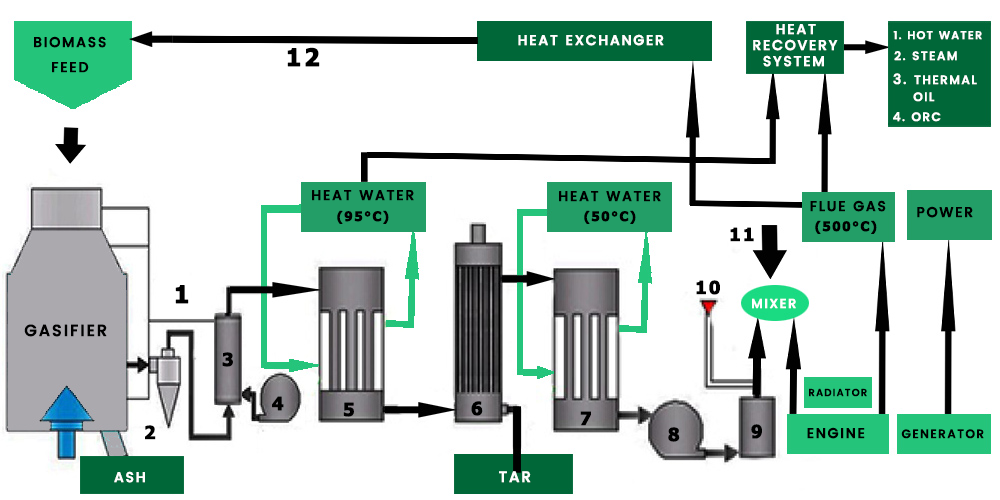
Scheme of principle of a CHP
1. Hot air;
2. Cyclone;
3., 5. si 7. Heat exchangers;
4. si 8. Blowers;
6. ESP;
9. Gas dryer;
10. Flare;
11. Air;
12. Drying air.

